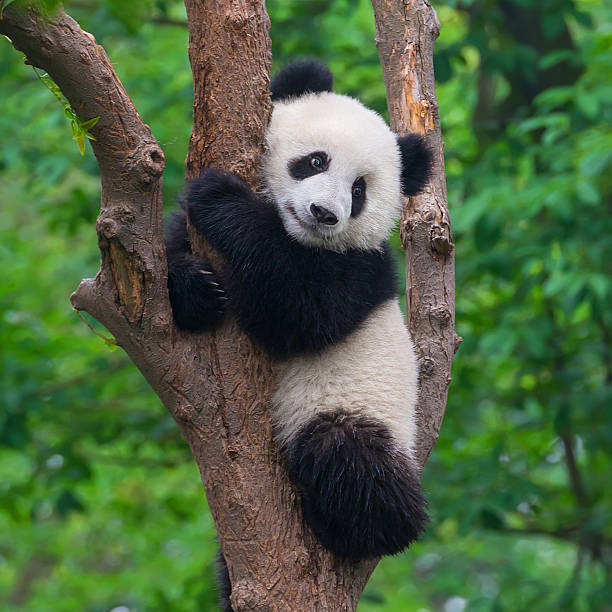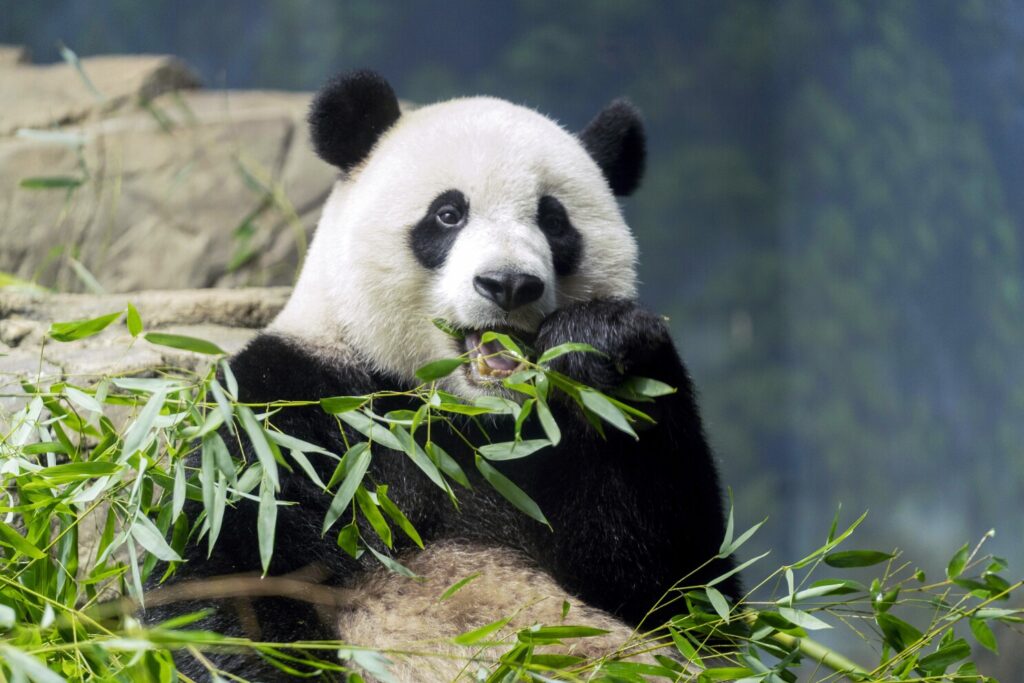Giant Panda: Taxonomy, Habitat, Conservation status
The giant panda (Ailuropoda melanoleuca) is a species of bear native to China.
Taxonomic classification:
- Kingdom: Animalia (Animals)
- Phylum: Chordata (Chordates)
- Subphylum: Vertebrata (Vertebrates)
- Class: Mammalia (Mammals)
- Order: Carnivora (Carnivores)
- Family: Ursidae (Bears)
- Genus: Ailuropoda
- Species: Ailuropoda melanoleuca

Species of Pandas:
There are two species of pandas:
Giant Panda (Ailuropoda melanoleuca):
The giant panda is the more well-known of the two species. It is native to China and is easily recognized by its distinctive black and white fur. Giant pandas primarily feed on bamboo, although they are technically omnivores and may eat small mammals and birds on occasion. They are classified as vulnerable by the International Union for Conservation of Nature (IUCN).
Red Panda (Ailurus fulgens):(https://kingwildlife.com/red-panda-taxonomy-habitat-diet-behavior-conservation-status/)
The red panda, also known as the lesser panda, is a smaller species of panda that is native to the eastern Himalayas and southwestern China. Red pandas have reddish-brown fur and a long, bushy tail. Unlike giant pandas, they are not bears but are classified in their own family (Ailuridae). Red pandas are primarily herbivorous, feeding on bamboo, berries, fruits, and small animals. They are also listed as vulnerable by the IUCN due to habitat loss and poaching.
Diet:
The giant panda’s diet primarily consists of bamboo, supplemented with occasional consumption of small mammals and birds. Despite being classified as omnivores, pandas have evolved to be herbivores with bamboo making up the majority of their diet. They have a unique “pseudo-thumb” that aids in grasping bamboo, and they need to consume a large volume of bamboo daily due to its low nutritional content.

Habitat:
Giant pandas inhabit mountainous regions in central China, particularly in provinces like Sichuan, Shaanxi, and Gansu. They are typically found in dense bamboo forests, which provide the primary source of their diet. The mountainous terrain offers a suitable environment for these bears, allowing them to seek shelter and roam in areas abundant with bamboo, their main food source. Conservation efforts focus on preserving and restoring the panda’s natural habitat to ensure their survival in the wild.

Mating behavior:
Polygynous
Giant pandas exhibit behaviors associated with what is known as “polygynous mating.” In polygynous mating systems, one male mates with multiple females during the breeding season.
Polygyny is a mating system in which one male lives and mates with multiple females but each female only mates with a single male.

Gestation period:
Female giant pandas have a gestation period of about 95 to 160 days, with the average duration being around 135 days. (5 Month).
Offspring:
Giant pandas give birth to relatively small litters, typically consisting of one or two cubs, (1 or 2 cubs).

Lifespan:
The lifespan of a giant panda is typically around 20 years in the wild, although some pandas have been known to live into their mid-20s or even longer in captivity.
In captivity, where they are provided with a controlled environment, a steady diet, and veterinary care, giant pandas can have a longer lifespan.

Population of Giant Pandas:
Only about 1,864 pandas remain in the wild, mostly in China’s Sichuan Province.
Conservation Status:
The conservation status of the giant panda (Ailuropoda melanoleuca) is “Vulnerable“ according to the International Union for Conservation of Nature (IUCN). The “Vulnerable” status indicates that the species faces a high risk of extinction in the wild.

Symbol of Conservation:
The giant panda is an iconic and symbolic species, often used as a symbol for wildlife conservation. It is also a cultural symbol of China and is often featured in various forms of art.

Conservation efforts:
Conservation efforts have been successful in increasing the population of giant pandas in recent years, but they continue to face threats to their survival, and ongoing conservation initiatives are crucial to ensure their long-term viability in the wild.

2 thoughts on “Giant Panda: Taxonomy, Habitat, Conservation status”
Dear Website Owner,
I hope this email finds you well. I recently discovered your website and was impressed by the quality of your content and the helpful information you offer to your audience. In light of this, I would like to propose a backlink exchange that could benefit both our websites.
My website, https://m.cheapestdigitalbooks.com/, is focused on providing affordable digital books to readers around the world. We currently have a strong online presence with a Domain Authority (DA) of 13, a Page Authority (PA) of 52, and a Domain Rating (DR) of 78. Our website features 252K backlinks, with 95% of them being dofollow, and has established connections with 5.3K linking websites, with 23% of these being dofollow links.
I believe that a mutually beneficial backlink exchange could be of great value for both of our websites, as it may lead to an increase in website authority and improve our search engine rankings. In this collaboration, I am willing to add backlinks from my website using your desired keywords and anchor texts. In return, I would be grateful if you could include backlinks with my desired keywords and anchor texts on your website.
I kindly request that you visit my website, https://m.cheapestdigitalbooks.com/, to get a sense of the potential benefits this partnership could bring to your site. I am confident that this collaboration will provide a win-win situation for both parties, and I look forward to learning more about your thoughts on this proposal.
Thank you for considering my offer. I am excited about the potential growth this partnership may bring to our websites and am eager to discuss the details further. Please do not hesitate to reach out to me at your convenience.
Best regards,
David E. Smith
Email: david@cheapestdigitalbooks.com
Address: 3367 Hood Avenue, San Diego, CA 92117
Sure David, i would love to…..